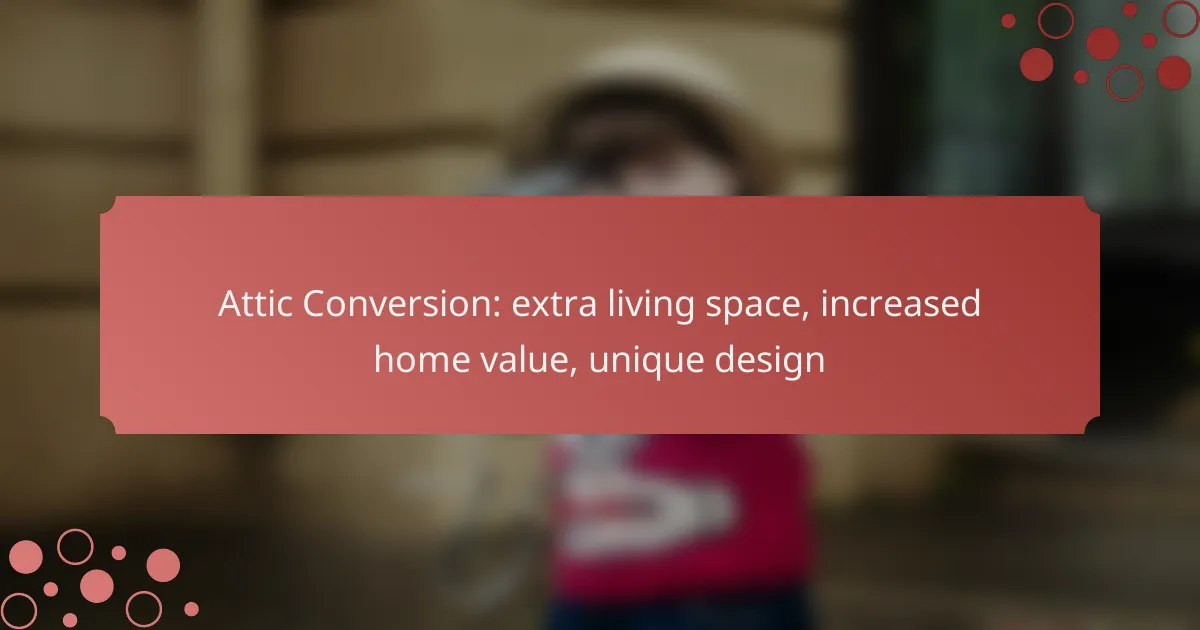An attic conversion is an excellent way to create extra living space while simultaneously increasing your home’s value. By transforming this often-overlooked area, homeowners can enjoy unique design possibilities, such as loft bedrooms or home offices, tailored to their needs. This enhancement not only boosts the property’s appeal but can also lead to higher resale prices in the competitive housing market.

How can an attic conversion increase home value in the UK?
An attic conversion can significantly enhance the value of a home in the UK by adding usable living space and improving overall property appeal. This transformation not only makes a home more attractive to potential buyers but can also lead to higher resale prices.
Enhanced property market appeal
An attic conversion increases a property’s market appeal by offering additional living space that can be tailored to various needs, such as a home office, guest room, or play area. This versatility attracts a wider range of buyers who are looking for functional and adaptable homes.
Moreover, well-designed attic spaces can showcase unique architectural features, making the property stand out in listings and viewings. A visually appealing conversion can create a lasting impression, encouraging potential buyers to consider the home more seriously.
Higher resale prices
Homes with attic conversions often command higher resale prices compared to similar properties without this feature. In the UK, the increase in value can range from 10% to 20%, depending on the quality of the conversion and the local market conditions.
Investing in a professional conversion can yield a return on investment that significantly outweighs the initial costs. Homeowners should consider the potential for increased property value when planning their conversion budget.
Attracting families and buyers
Families are particularly drawn to homes with attic conversions, as they provide extra space for children to play or for creating a dedicated study area. This additional room can be a deciding factor for buyers with growing families who need more space without moving to a larger property.
Furthermore, the appeal of a well-executed attic conversion can attract first-time buyers looking for affordable options in desirable areas. By offering more living space in a compact footprint, these conversions can make properties more competitive in the housing market.

What are the design options for attic conversions?
Attic conversions offer a variety of design options that can enhance your home’s functionality and aesthetic appeal. Common choices include loft bedrooms, home offices, and creative playrooms, each tailored to maximize the unique space available in your attic.
Loft bedroom designs
Loft bedrooms are a popular choice for attic conversions, providing a cozy and private retreat. When designing a loft bedroom, consider the ceiling height and natural light; dormer windows can significantly improve both. Aim for a balance between comfort and space efficiency by incorporating built-in storage solutions.
Using light colors and mirrors can create an illusion of more space, making the room feel larger. Additionally, ensure proper insulation and ventilation to maintain a comfortable temperature year-round.
Home office conversions
Transforming your attic into a home office can create a quiet workspace away from the hustle and bustle of the main living areas. Focus on creating a functional layout that includes adequate desk space, shelving, and electrical outlets. Natural light is crucial, so consider skylights or windows that can enhance productivity.
To avoid distractions, soundproofing may be beneficial, especially if the attic is near noisy areas of the home. Ergonomic furniture can also improve comfort during long working hours.
Creative playrooms
Attic playrooms can be a fantastic way to provide children with a dedicated space for creativity and fun. Design considerations should include safety features, such as soft flooring and secure storage for toys. Bright colors and playful decor can stimulate imagination and make the space inviting.
Incorporating multifunctional furniture, like foldable tables or storage benches, can help maximize the area while keeping it organized. Ensure there is adequate lighting, both natural and artificial, to create a cheerful environment for playtime.

What are the costs associated with attic conversions in the UK?
The costs of attic conversions in the UK can vary significantly based on factors such as size, design, and location. Generally, homeowners can expect to spend anywhere from £20,000 to £50,000, depending on the complexity of the project and the materials used.
Average conversion costs
On average, a basic attic conversion can cost between £20,000 and £30,000, while more elaborate designs may reach £40,000 or more. Factors influencing these costs include structural changes, insulation requirements, and the need for additional plumbing or electrical work.
For a loft conversion that includes a bathroom, costs can increase significantly, often exceeding £50,000. It’s essential to obtain multiple quotes from contractors to ensure competitive pricing.
Cost-saving tips
To save on attic conversion costs, consider opting for a simple design that requires minimal structural changes. Avoiding extensive plumbing and electrical work can also help keep expenses down.
Another effective strategy is to source materials locally or consider second-hand options for fixtures and fittings. Planning your project during off-peak seasons may also lead to lower labor costs.
Financing options
Homeowners can explore various financing options for attic conversions, including personal loans, home equity loans, or remortgaging. Personal loans typically offer quick access to funds but may come with higher interest rates.
Home equity loans allow you to borrow against the value of your home, often at lower rates. It’s advisable to consult with a financial advisor to determine the best option based on your financial situation and project scope.

What are the building regulations for attic conversions?
Building regulations for attic conversions ensure that the new living space is safe, accessible, and energy-efficient. These regulations vary by location, so it’s essential to check local guidelines before starting your project.
Planning permission requirements
In many areas, planning permission is required for attic conversions, especially if you are altering the roof structure or extending the property. Typically, you may need to submit detailed plans and specifications to your local planning authority.
Some regions offer permitted development rights, allowing certain types of conversions without formal permission. However, these rights often come with restrictions, such as height limits and design guidelines, so it’s crucial to verify your eligibility.
Building regulations compliance
Building regulations compliance covers various aspects, including structural integrity, fire safety, insulation, and ventilation. Your attic conversion must meet specific standards to ensure it is safe and habitable.
Common requirements include installing proper stair access, ensuring adequate headroom, and using fire-resistant materials. Engaging a qualified builder or architect can help navigate these regulations and ensure your project meets all necessary standards.

What are the benefits of attic conversions?
Attic conversions offer several advantages, including additional living space, enhanced home value, and opportunities for unique design. These benefits make them an appealing option for homeowners looking to maximize their property’s potential.
Increased living space
Converting an attic into a functional living area can significantly expand your home’s usable space. This extra room can serve various purposes, such as a bedroom, office, or playroom, catering to your family’s needs.
When planning an attic conversion, consider the existing structure and ceiling height. Ideally, a minimum height of around 2.4 meters (8 feet) is recommended for comfortable living. If your attic meets this requirement, the potential for increased living space is substantial.
Energy efficiency improvements
Attic conversions can enhance your home’s energy efficiency by improving insulation and sealing air leaks. Proper insulation in the converted space can help maintain a consistent temperature, reducing heating and cooling costs.
Homeowners should consider using energy-efficient materials and technologies during the conversion process. For example, installing double-glazed windows can further minimize energy loss, making the attic a more comfortable and cost-effective living area.
Personalized design opportunities
One of the most appealing aspects of an attic conversion is the chance to create a personalized space that reflects your style. From custom-built furniture to unique architectural features, the design possibilities are virtually limitless.
When designing your attic, think about how to maximize natural light and maintain a cozy atmosphere. Skylights or dormer windows can enhance the space while providing ventilation, making it a pleasant area to spend time in.
